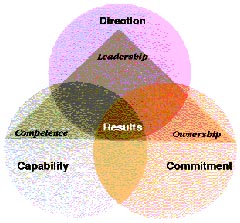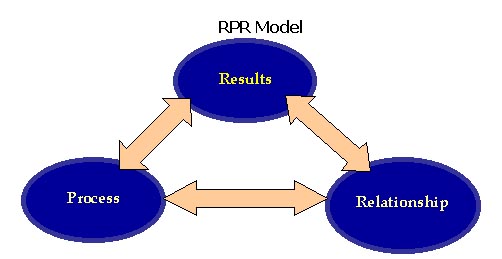
"It is
impossible for ideas to compete in the marketplace if no forum for
their presentation is provided or available." � �Thomas Mann, 1896
People Issues that Cause e-Commerce Projects to Fail
Author: Carmen Robinson
Contributed by Interaction Associates
Introduction
In today’s fast-paced business environment, organizations are rushing to keep pace with rapid changes in technology. Many companies spend tremendous amounts of time and money analyzing and refining technology strategies, but don’t give sufficient thought and attention to how they can best execute that strategy.
What leaders may not realize is that an organization’s culture and people can significantly impact the success or failure of technology implementation. In many cases, projects fall short, fail, or cost much more than anticipated --- not because of the technology itself, but because of organizational issues.
What Causes Projects To Fail?
Some of the key reasons technology projects fail include: lack of cross-functional teamwork, involving staff members too late, unrealistic expectations, inadequate team skills, and overall resistance to change.
Forward-thinking organizations can prevent many of these pitfalls, saving time, stress and money, by following a pathway that includes the following:
-
Enrolling key stakeholders in the planning phase,
-
Communicating the benefits of the system to all affected operating units,
-
Conducting an assessment of the technology’s impact on job tasks, functions and employee roles in execution, and
-
Building work systems and processes that minimize the assessed impact.
Technology projects can also fail if their strategy does not link with the overall business strategy, or if there is no executive-level sponsorship or senior leader consensus around the business need for the project. Project leaders can build executive level buy-in by demonstrating the link to the organization business strategy and making clear the organization-wide benefits.
When leaders don’t communicate technology strategies and anticipated benefits, or underestimate the impact to the organization, projects may go wrong or fail to achieve intended business results. Given the potential risk to technology strategies, organizations must build into the equation the people who are affected by the systems implementation.
A report by The Gartner Group states, “In the planning phase of a strategic application project, up to 40% of the total cost should be allocated to people issues.”
Organizations that do not focus up front on employee commitment, understanding and capabilities run the risk of spending too much time and money at the back end, trying to resolve internal problems.
Aligning the organization to deliver a successful systems implementation
Successful alignment of people to deliver on a strategy depends on the way direction is developed, the level of commitment within an organization, and the ability to transfer capability throughout the organization.
Interaction Associates uses a change management model that provides a framework for moving from strategy to implementation. This encourages groups to consider all of the crucial components that go into managing strategic change. The change model includes Direction Setting, Commitment Building and Capability Transfer. It is based on the principle that collaborative action is the most effective way to implement strategy.

Direction Setting:
When setting direction, executives must analyze the systems implementation strategy. Some of the questions that need to be answered are:
-
Is leadership aligned on the expected business results?
-
Do leaders understand how they will measure these results?
-
Is there buy-in from key stakeholders?
-
Is there an understanding of the project’s impact within the organization?
Answers to these questions will reveal if direction has been properly set, is agreed upon, and is understood by key stakeholders.
Commitment Building:
To increase the likelihood of success, project leaders must concentrate on cultivating broad-based buy-in throughout the organization. There should be a shared, system-wide understanding of the impact and benefits of the technology implementation. Commitment building efforts cannot involve only Information Technology areas or specific executives, but must include employees in all operating units impacted by the initiative.
Leaders should address these types of questions during commitment building:
-
Do employees understand the impact and benefits?
-
How involved are stakeholder groups in the system design and implementation?
-
Have users concerns been addressed?
-
Do people understand how their jobs will be impacted?
Capability Transfer:
The ability to transfer capability throughout the organization is critical. The organization must be able to perform in the new environment. This means assessing existing skill levels and making certain that required knowledge, skills and abilities needed to operate in the new system have been transferred to the appropriate employees.
Some questions to ask in this phase include:
-
What is the plan to train people on the new system?
-
To what extent will people need to be educated about new business processes or ways of working?
Project
Success Indicators
The Do’s and Don’ts of a Successful Implementation
In developing plans for large-scale systems implementation, organizations can evaluate the potential for a success by looking at a set of project success indicators.
Project managers can use these success indicators as guidelines to assess the organization’s readiness for a technology implementation.
-
Technology strategy maps to the organization’s business objectives,
-
Key leaders are involved in the planning, communication and execution phases,
-
Benefits of the proposed system are clear and obvious to all affected business units,
-
Identified business sponsors help spread the word about the project’s impact and opportunities,
-
Technology plans, impact and benefits are made obvious early in the planning,
-
Organizational readiness has been assessed ---the organization is ready for change, and there are no other conflicting issues or initiatives being implemented simultaneously,
-
There is a shared understanding and agreement of the magnitude of impact in the organization, and
-
Key levers needed to make effective change are identified.
There are also activities and actions that can increase the risk of project failure or system breakdown in the organization. Project managers should avoid these pitfalls in moving from planning to implementation.
-
Don’t keep the initiative a secret. Communicate plans early and extensively throughout the organization,
-
Don’t ignore or minimize user concerns. Instead talk with users up front and enroll and engage them in the benefits of the initiative,
-
Don’t get lost in the minutiae. Keep the focus on the big picture and goals of the initiative. Keep the focus strategic,
-
Don’t ignore other projects in the organization,
-
Don’t assume you have the requisite skills. Have a clear understanding of what you do well as an organization. Get help with the other parts.
Assessing The Results
When technology initiatives have been implemented, how can you determine if the project has been successful? A measure of success lies in the ability to achieve sustained results from the technology initiative.
Accomplishing sustained results means having the ability to duplicate results each time a strategy is implemented. This means that other initiatives will yield similar success if repeated, using the same people and the same process to accomplish established goals.
"Sustained results" also means the goals achieved by the technology initiative are far-reaching and offer enduring impact. Business units affected by a systems implementation should experience the benefits in both short-term and long-term scenarios.
The ability to achieve sustained results springs from paying attention to three critical areas: results, process, and relationships.
Dimensions for Success
The Interaction Associates’ RPR (results, process, relationships) Model offers a method for evaluating the planning, development and execution phases of a systems implementation.
 |
By using the RPR Model as a guide, project leaders will be less likely to miss or disregard key results areas in moving from strategy to implementation. Interaction Associates uses the RPR Model to achieve success at the Double Bottom Line: meaning realization of both outstanding business results and satisfying relationships at work.
Your Successful Systems Implementation
The Internet is altering the way business operates today. New technologies and rising customer expectations dictate that organizations keep pace with evolving opportunities in e-business.
A great strategy is only as good as its execution and implementation. By incorporating people and culture issues into project plans, organizations will be positioned to achieve business objectives. Successful technology implementation can translate into enhanced customer satisfaction, greater efficiency, and increased market share - delivering on the overall business strategy.
Editorial Policy: Nothing you read in The Business Forum Journal should ever be construed to be the opinion of, statements condoned by, or advice from, The Business Forum Institute, its staff, workers, officers, members, directors, sponsors or shareholders. We pass no opinion whatsoever on the content of what we publish, nor do we accept any responsibility for the claims, or any of the statements made, within anything published herein. We merely aim to provide an academic forum and an information sourcing vehicle for the benefit of the business and the academic communities of the Pacific States of America and the World. Therefore, readers must always determine for themselves where the statistics, comments, statements and advice that are published herein are gained from and act, or not act, upon such entirely and always at their own risk. We accept absolutely no liability whatsoever, nor take any responsibility for what anyone does, or does not do, based upon what is published herein, or information gained through the use of links to other web sites included herein. Please refer to our: legal disclaimer
The Business Forum
Beverly Hills, California, United States of AmericaEmail: [email protected]
Graphics by DawsonDesign
Webmaster: bruceclay.com
� Copyright The Business Forum Institute - 1982 - 2015 ** All rights reserved.
The Business Forum Institute is not responsible for the content of external sites.